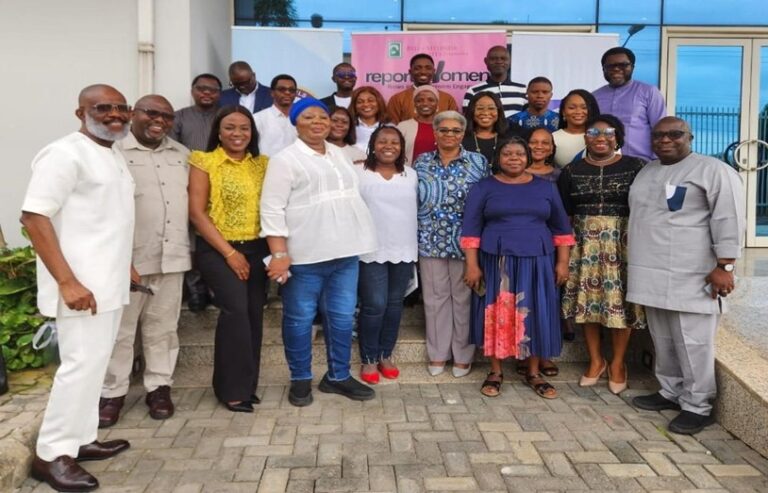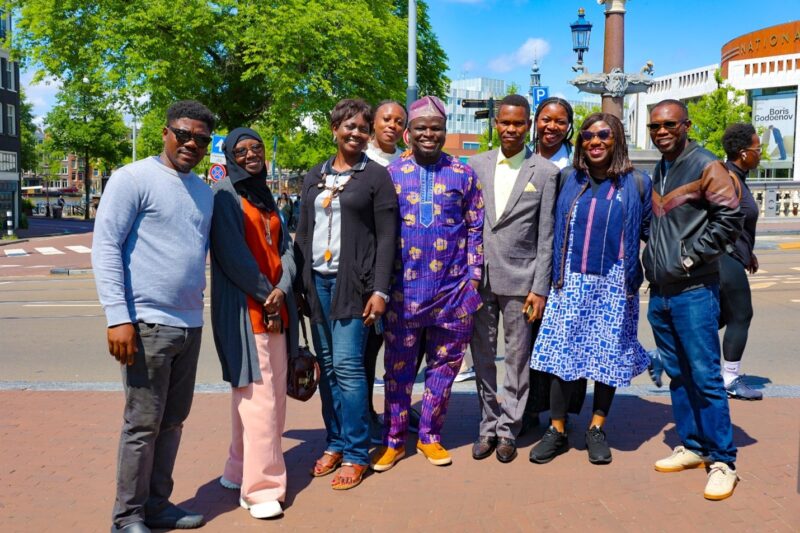The management of Channels Television has reaffirmed its commitment to gender parity in the leadership of newsroom and news. Kingsley Uranta, General Manager, Channels Academy; and Ambrose Okoh, General Manager, News and Current Affairs, stated this during the House-to-House visit of the Wole Soyinka Centre for Investigative Journalism (WSCIJ) to its headquarters in Lagos, on Friday, 30 August 2024. The visit which is an activity under WSCIJ’s Report Women! News and Newsroom project was aimed at sharing WSCIJ’s recent report, “Who leads the newsrooms and news?”, thereby canvass for increased inclusion of women in the leadership of newsrooms and news.
Welcoming the WSCIJ team, they noted that Channels Television is an inclusive and an equal opportunity organisation, with more women in leadership than their male counterparts because the organisation believe women have much to offer. They noted that they look forward to listening to WSCIJ’s report.
The session moderated by Bukola Coker, News Anchor and Reporter, Channels Television, saw Motunrayo Alaka, Executive Director/CEO, WSCIJ, and a faculty comprising Bimbo Oloyede, veteran broadcaster, and Dapo Olorunyomi, founder, WSCIJ and publisher, Premium Times, share with the Channels Television team.
Presenting the findings of WSCIJ’s report, Alaka said the voice and face of news in Nigeria media is masculine. Women account for 26.9% of management positions and 24.2% of the board in Nigerian newsrooms, with the South West having the least proportion of women in management and North West, the highest. Also, 24% of anchors/authors and 12.1% of expert resource persons are women, and 7.1% of stories are about women and girls. She argued that it makes natural, ethical, legal, editorial and economic sense to intentionally feature women as leaders of the newsroom and news, adding that the media should lead morally in the inclusion of women.
On his part, Olorunyomi, argued that journalism must align with the core principles of democracy, particularly in promoting participation and representation. He noted that journalism, as a key tool of democracy, should mirror the democratic values it seeks to advance. If the media fails to achieve gender parity within its own ranks, it undermines its ability to promote those same values in society. He stressed that diversity in the newsroom is essential for fairness and as a fundamental philosophical requirement to uphold the integrity of journalism and its role in supporting self-governing communities. Every argument for diversity, he noted, ultimately ties back to this foundational principle.
Oloyede shared with Channels Television how to adapt the mentoring principles of the Report Women! champion building to raise the profile of women in the newsroom. She shared six key areas where media managers can impact the female journalists in their charge—Skill development, career Development, networking, problem-solving, confidence building and role modelling. She noted that the presence of women in senior roles in Channels Television is good for the career growth of female journalists. She clarified that while promotions should not be automatic, it is crucial to give credit where it is due and to provide women with equal opportunities to excel in their careers.
During the Q&A session, participants raised questions about the factors contributing to North West’s leadership in newsroom gender equality and possible reasons the South West lags. Concerns were also expressed about the challenges in encouraging women to speak up and actively participate in media leadership. In response, it was noted that although there are more women in the South West, the overall proportion of women in leadership remains skewed towards men. Emphasis was placed on being more empathetic towards women, considering pre-recording to accommodate their needs, and celebrating the achievements of existing women leaders to encourage more participation and leadership.
Speaking on behalf of Channels Television, Uranta said the presentation was eye-opening and acknowledged the ongoing collaboration between WSCIJ and Channels Television. He reeled out a longlist of women holding top leadership positions in the organisation, including a senior broadcast engineer. Also, Okoh affirmed that the organisation’s owners are attentive to women’s issues and empathetic towards their needs, expressing a strong partnership with WSCIJ. He commended the report as a valuable resource.
Samson Ademola, Programme Officer, WSCIJ, thanked the leadership of Channels Television for the reception. He noted excitement at the intentional inclusion of women as leaders in their newsroom and urged that they do more. 21 members of the management and staff of Channels Television participated in the session. They include Ronke Raji, Controller News; Adejoke Rogers, Assistant Controller News; Simon Ejembi, Head, Digital; Ayoola Kassim, Head of Programmes; Kayode Okikiolu, Senior Presenter/Reporter; and Yomi Otaigbe, Senior Reporter/Presenter.
The House-to-House initiative was designed to take training or advocacy on media matters to media houses to engage both their management and staff members. WSCIJ has used the initiative in the past to canvas for the creation of investigative journalism desk, gender policy and practices in the newsroom under the Report Women! project, and improved reporting for the energy desk.
The engagement at Channels Television is a component of the Report Women! News and Newsroom Engagement project, which engages the management and staff of news media organisations to increase the representation of women as leaders in their coverage and newsrooms. The project is supported by the Bill and Melinda Gates Foundation. The WSCIJ will visit more media houses in the coming weeks to share and engage on findings from the ‘Who leads the newsrooms and news?’ report and the project.








